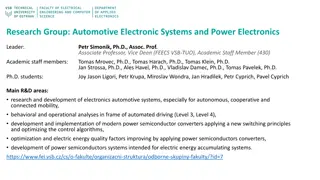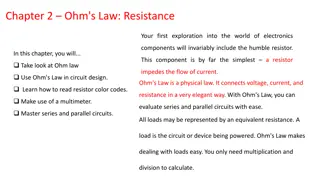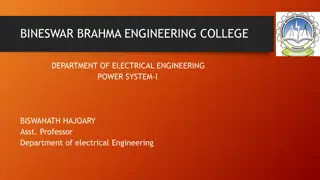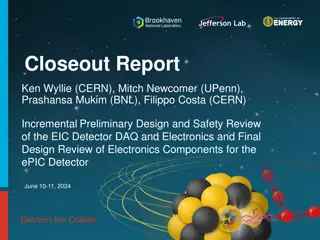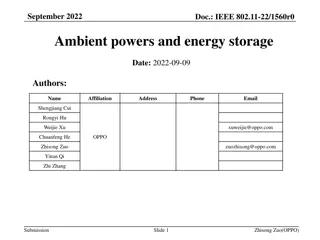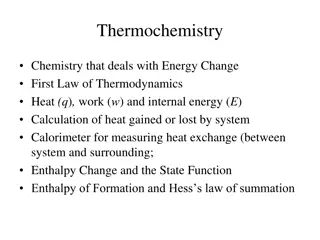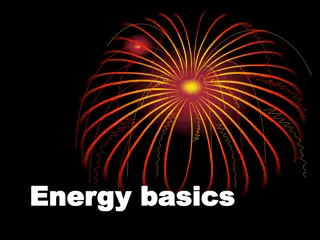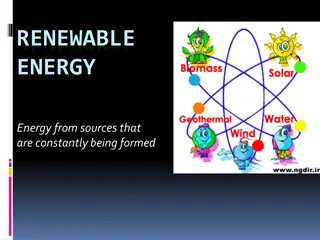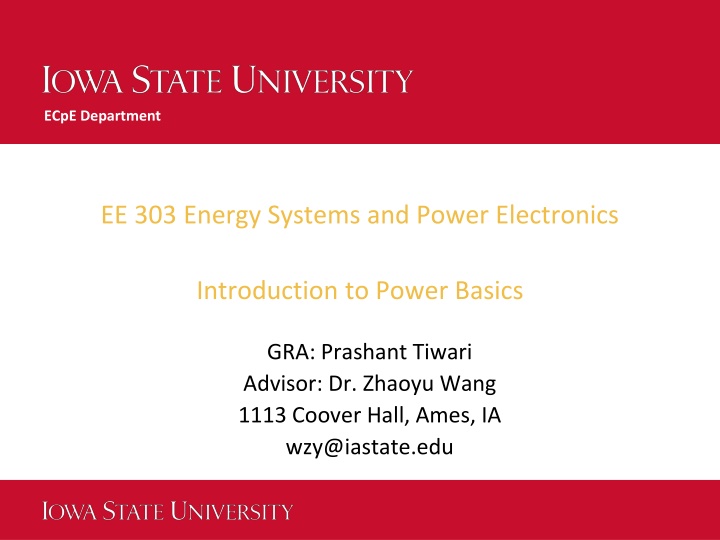
Introduction to Power Basics in Energy Systems and Power Electronics
Delve into the fundamental concepts of power basics, phasor analysis, mathematical operations, time domain representation, and phasor domain representation in the context of energy systems and power electronics. Explore the relationship between complex numbers, exponential forms, polar forms, and rectangular forms in electrical engineering. Understand the principles of electrical components like resistors, inductors, and capacitors in both time domain and phasor domain. Enhance your knowledge of electrical systems through detailed discussions on voltage, current, RMS signals, and more.
Download Presentation

Please find below an Image/Link to download the presentation.
The content on the website is provided AS IS for your information and personal use only. It may not be sold, licensed, or shared on other websites without obtaining consent from the author. If you encounter any issues during the download, it is possible that the publisher has removed the file from their server.
You are allowed to download the files provided on this website for personal or commercial use, subject to the condition that they are used lawfully. All files are the property of their respective owners.
The content on the website is provided AS IS for your information and personal use only. It may not be sold, licensed, or shared on other websites without obtaining consent from the author.
E N D
Presentation Transcript
ECpE Department EE 303 Energy Systems and Power Electronics Introduction to Power Basics GRA: Prashant Tiwari Advisor: Dr. Zhaoyu Wang 1113 Coover Hall, Ames, IA wzy@iastate.edu
Phasor Complex Number: ? = ? + ?? Exponential Form: ? = ? .???; where, ? = ???= cos? + sin? ?2+ ?2, ? = arctan? ?, Polar Form: ? = ? ? Rectangular Form: ? = ? cos? + ? ? sin? Conjugation: ? = ? ?? 2 EcPE Department
Mathematical Operations ?1+ ?2= ?1+ ??1+ ?2+ ??2 = (?1+ ?2) + ?(?1+ ?2) ?1.?2= (?1+??1). ?2+ ??2 = (?1?2 ?1?2) + ? (?1?2+ ?1?2 = ?1 ???1. ?2 ???2= ?1 ?2 ??(?1+?2) 3 EcPE Department
Time Domain ? ? = ????cos(?? + ??) I ? = ????cos(?? + ??) ; where, ? = 2??;? ?? 60?? 4 EcPE Department
Time Domain VS Phasor Domain Objective: Phasor Domain Analysis for simplifying calculations Assumption: Constant frequency system Sine Wave 5 ECpE Department
Time Domain Representation We discussed in Lecture 1, the Time domain representation of voltage and current are, ? ? = ????cos(?? + ??) I ? = ????cos(?? + ??) Root Mean Square (RMS) of a sine signal is, ??2? ?? = 1 ? 0 ???? 2; ? ??? ? =1 ? ? = 6 ECpE Department
Contd ? ? = 2 ? cos(?? + ??) 2 ? cos(?? + ??) (i) I ? = 2 ? Re [??(??+??)] 2 ? Re [??(??+??)] ? ? = .. .. (ii) I ? = Note: [For conversion of equation (i) to (ii)] As, ???= cos? + ?sin? ??(??+??)= cos(?? + ??) + ?sin(?? + ??) Real Part Imaginary Part 7 ECpE Department
Phasor Domain Representation Voltage and Current can be represented in phasor domain as, ? = ? ????= ? ??= ? cos??+ ? ? sin?? I = ? ???? = ? ?? = ? cos??+ ? ? sin?? Exponential Rectangular Polar 8 ECpE Department
Representation of Electrical Components Component Time Domain Phasor Domain Resistor ? ? = ?.?(?) ? = ?.? ? ? = ?.? ?(?) ? = ???.? Inductor ?? ? 1 ? ? =1 ? = ???.? ? ? ? ?? + ?(0) Capacitor 0 9 ECpE Department
Impedance Z denotes the impedance. Mathematically, ? = ? + ??, where R = resistance and X = reactance = ? + ? ?? ?? 1 = ? + ? ?? ?? Note: Here, ??= ??and is called Inductive Impedance and, ??= 1 ??and is called Capacitive Impedance 10 ECpE Department
Contd.. Expression of ? in polar form. As, ? = ? + ?? In Polar Form, ? = ? ; where, ? = ?2+ ?2 and =arctan(? ?) The reciprocal of Impedance is termed as admittance. 1 ? i.e. ? = 11 ECpE Department
Example 1: Find i(t) The voltage source in the figure shown is defined as ? ? where, ? ? = 2 100 cos(?? + 30) Find i ? . 12 ECpE Department
Solution Given, R = 4 , X = ?? = 2 ?? = 3 ? = 4 + ?3 ? ? = 2 100 cos(?? + 30) 42+ 32= 5 and 3 4 ? = =arctan = 36.9o Now, I = ? ?=100 30 5 36.9= 20 6.9o A ? ? = 20 2cos ?? 6.9 13 ECpE Department
Complex Power where, ? ? = ????cos(?? + ??) I ? = ????cos(?? + ??) P???? ? = ? ? .? ? cos?cos? =1 2[cos ? ? + cos ? + ? ] p???? ? =1 2 ???? ????[cos ?? ?? + cos 2?? + ??+ ??] ????? ? =1 2 ???? ????[cos ?? ?? + cos 2(?? + ??) (?? ??) ] ????? ? =1 cos(? ?) = cos????? + sin?sin? 2 ???? ????cos ?? ?? {1 + cos[2 ?? + ??]} + 1 2 ???? ????sin ?? ?? si?[2 ?? + ??]} 14 ECpE Department
Contd ??????(?)dt Average Power =1 2 0 =1 2????????cos(?? ??) = ? ? cos(?? ??) Power factor Angle ( ) Power factor (pf) = cos [pf lies between 0 and 1] Average power is also referred as active power. 15 ECpE Department
Contd Note: 1. If current leads voltage, ?? ?? < 0 then pf is leading. 2. If current lags voltage, ?? ?? > 0 then pf is lagging. 16 ECpE Department
Contd Active Power (P)= ? ? cos(?? ??) Reactive Power (Q) )= ? ? sin(?? ??) (Watts) (VAr) Complex Power, S = P+jQ S = ? ? [cos ?? ?? + ?sin(?? ??)] = ?.? = ? ??. ? ?? = ? ? (?? ??) (Unit of S is usually VA, kVA) 17 ECpE Department
Contd Magnitude of Apparent Power: ?2+ ?2 ? = ? . ? = The real power, reactive power and apparent power can be represented as shown in the figure. The figure is called power triangle. From Power Triangle, we can get, ? = ?.cos ? = ?.sin = ? 1 ??2 18 ECpE Department
Example 2: A load draws 100kW with leading pf of 0.85. What is , Q and S? Solution: 19 ECpE Department
Contd Q. A load draws 100kW with leading pf of 0.85. What is , Q and S? Solution: = cos 0.85 = 31.80 ? Apparent Power (S) = cos = 117.6 Kva Reactive Power (Q) = ?.sin = 62???? Complex Power (S) = ? + ?? = 100 ?62 20 ECpE Department
Review Voltage Phasor: ? = ? ??= ? cos??+ ? ? sin?? Complex Power: S = ? ? [cos ?? ?? + ?sin(?? ??)] = ? + ?? = ? ? P is Real Power/ Active Power, Units W, kW, W Q is Reactive Power, Units VAr, kVAr, VAr S is Complex Power, Units VA, kVA, va 21 ECpE Department
Contd Power factor Angle: = ?? ?? Power factor (pf): cos (value ranges from 0 to 1) Leading pf: current angle leads voltage angle (?? ?? < 0). Lagging pf: current angle lags voltage angle (?? ?? > 0). 22 ECpE Department
39 Bus Test System Bus Transformer Load (P+jQ) Line (Z=R+jX) 23 ECpE Department
118 Bus Test System 24 ECpE Department
Example 1: The voltage source in the figure shown is defined as ? ? where, ? ? = 100 300 25 ECpE Department
Solution We know, I = ? ?=100 30 4+?3= 20 6.9o A S = ?.? = 100 30o 20 6.9o= 2000 36.9o = 2000 36.9o VA= 1600 W + j1200 VAr 1200 1600 =arctan = 36.9o cos = ?? = 0.8 (lagging) Now, ??= ?? .? = 4 20 6.9o 20 6.9o = 1600 W ?2.? ??= ?? .? = 3j 20 6.9o 20 6.9o = 1200 ??? ?2.? 26 ECpE Department
Contd Notes: Inductors only consume reactive power. ?????????= ????????? Capacitors only generate reactive power. 2.?? where, ??= ??L 2.?? ??????????= ?????????? 1 ? where, ??= ?? ???= 27 ECpE Department
Example 2: Assume a load 100 kVA with pf=0.8 lagging, where as correct pf is 0.95 lagging. Find the value of reactive power that must be injected to maintain the correct pf. 28 ECpE Department
Example 2: Assume a load 100 kVA with pf=0.8 lagging, where as correct pf is 0.95 lagging. Find the value of reactive power that must be injected to maintain the correct pf. S = P+jQ = 80+j60 = ???cos0.8 = 36.9? = ???cos0.95 = 18.2? tan18.2?=60 ???? 80 ????= 33.7 kVAr 29 ECpE Department
Thank You! 30 EcPE Department






